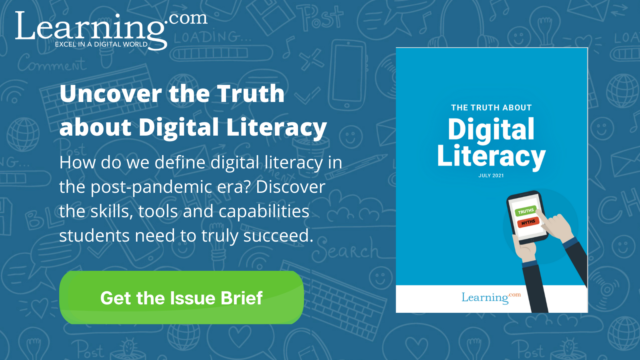Digital literacy encompasses the skills required to use technology safely, effectively and responsibly. As technology continues to become more and more ingrained in daily life, the importance of learning digital literacy skills is becoming increasingly apparent.
What is Digital Literacy: Definition
Digital literacy means having the skills to effectively use technology, and the knowledge and skills to do so safely and responsibly. “Digital” refers to technology, ranging from computers and the internet to technological objects and programs such as cellphones, smart home systems, check-in kiosks at airports and more. Literacy refers to the ability to use this technology—and to use it well.
The phrase “digital literacy” is an ambiguous one, but that’s kind of the point. Once predicated on the existing “literacies” of the time, (e.g. information literacy and computer literacy, as referenced in Digital Literacy by Paul Gilster), the modern definition has grown significantly in line with the advancement and evolution of existing technologies. Now, instead of outlining which technologies, exactly, are included in “digital literacy,” the phrase more commonly refers to literacy that broadly encompasses technology. This helps to prevent the need to redefine the “digital” aspect of the phrase.
Uses of Digital Literacy in Everyday Life
As technology becomes increasingly prominent in our daily lives, it’s more important than ever that digital literacy be included as a fundamental life skill taught in education. Not only should students be able to use computers effectively, but their digital literacy skills should span far beyond the computer.
Whether we are conscious of it or not, most people engage in digital systems multiple times a day. For instance, the following technological uses require some amount of digital literacy to perform or interact with:
- Communication
- Cell phones
- Texting
- Online chat
- Video calls/conference calls
- Social media platforms
- Home Management
- Alarm clocks
- Smart home devices
- Home security systems or “smart” doorbells
- Shopping
- Online ordering
- Online classifieds
- Mobile shopping/delivery apps
- Real-time shopping updates and tracking
- News/Education
- Online news
- Digital learning programs
- Online searches
- Webinars
- Video streaming
- Digital portfolios
- Data analysis
- Educational games/apps (such as foreign language learning applications)
- Healthcare
- Health/exercise tracking apps
- Virtual doctor visits
- Digital medical records
- Online/by-phone bill pay
- Online prescription refills
- Entertainment
- Video streaming
- Digital books/audiobooks
- Podcasts
- Photo management
- Photo/video editing
- Smart TVs
- Finance
- Banking
- Portfolio management
- Virtual payment methods
- Professional
- Job searching
- Work functions
- Communication
- CRM/CMS
- Storing and retrieving records
- Time tracking/management software
- Task management software
- Accounting/tax preparation
What’s more, is that this list of examples is going to be quickly outdated as technology is advancing and adapting faster than ever!

Why is Digital Literacy Important?
While digital literacy was originally seen as a skill that was beneficial for career readiness—specifically for higher-paying technology-related jobs—it is now seen as an integral life skill. Digital literacy still provides career readiness; however, it is also crucial to education and socialization, and is even becoming more ingrained in day-to-day actions from smart home systems and security, banking, shopping, driving and utilizing vehicle features and more.
To learn more about why digital literacy is important, explore our recent blog: Why Digital Literacy is Important for Students.
Learn More
Learning.com creates learning programs for educators to implement digital literacy curriculum easily and effectively in the classroom. Learn more about our flagship program, EasyTech, by clicking the button below.

Learning.com Team
Staff Writers
Founded in 1999, Learning.com provides educators with solutions to prepare their students with critical digital skills. Our web-based curriculum for grades K-12 engages students as they learn keyboarding, online safety, applied productivity tools, computational thinking, coding and more.
Further Reading
What Is Digital Citizenship? Key Skills & Best Practices for Students
In a world dominated by virtual interactions, being a responsible digital citizen has never been more crucial. Students today grow up with social...
Teaching Children How to Effectively Handle Cyberbullying
In today’s digital age, online safety is a critical concern for children navigating the internet. While the internet provides endless opportunities...
Examples of Abstraction in Everyday Life: How Students Already Use Computational Thinking
Computational thinking, though often perceived as a concept limited to technology or coding, is a valuable problem-solving skill that students...




